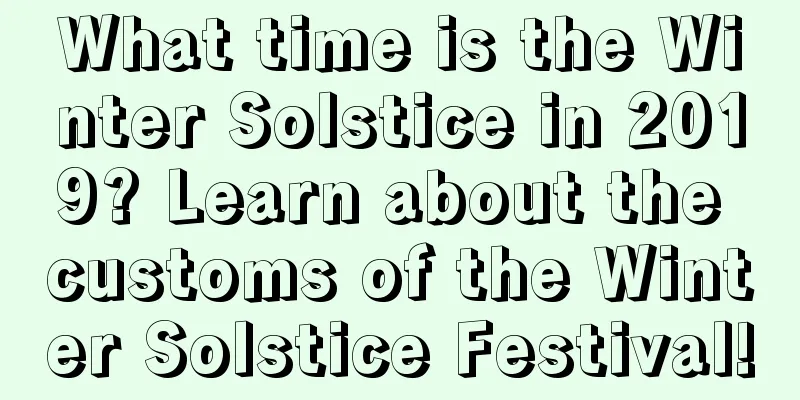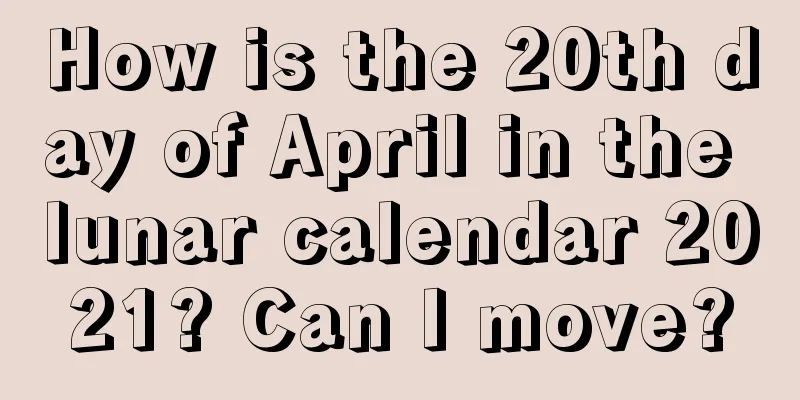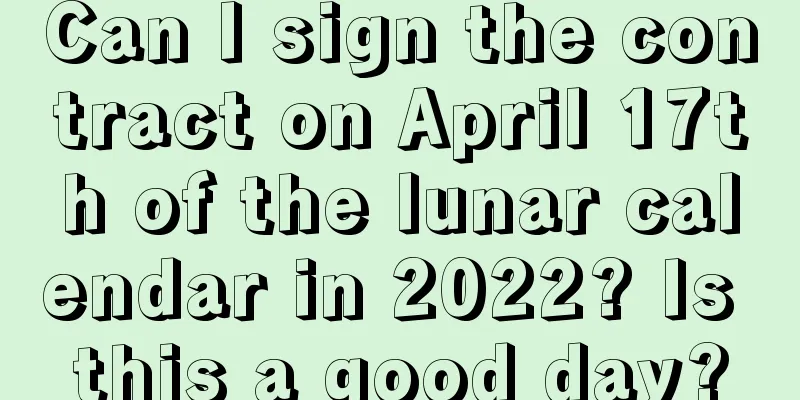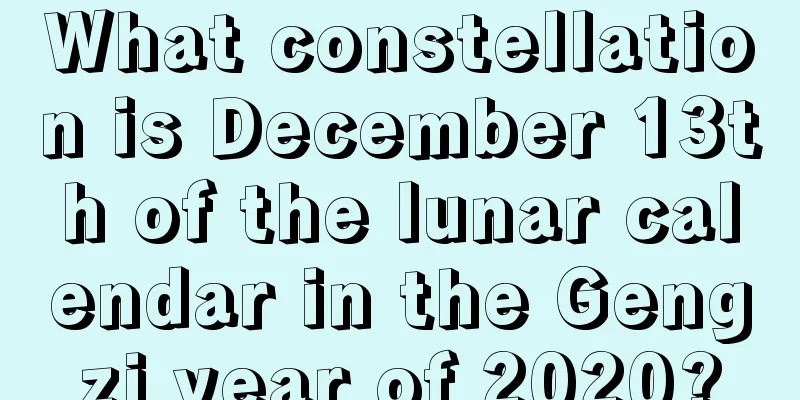What time is the Winter Solstice in 2019? Learn about the customs of the Winter Solstice Festival!

Introduction: The Winter Solstice usually falls on December 21 or 22 of the Gregorian calendar. It has no fixed date and is also called the "live festival." So, what time is the Winter Solstice in 2019? Let’s learn about the customs of the Winter Solstice Festival! The eleventh month of the lunar calendar is a new month. What should we do and what should we avoid in this new month? Follow Shuimoxiansheng.com and take a look at the contents of the lunar calendar for November 2019.What time is the winter solstice in 2019?The start time of the 2019 Winter Solstice is:Gregorian calendar: Sunday, December 22, 2019 12:18:29 Lunar calendar: November 27, 2019 (winter month) at noon Winter Solstice - There is such a record in "Book of the Later Han": "Before and after the winter solstice, gentlemen rest themselves and rest their bodies, officials stop working and do not attend to government affairs, and choose auspicious days to do things." So on this day, the court would take a day off, businesses would stop operating, relatives and friends would give each other delicious food and visit each other, happily spending a holiday of "resting and resting the body." During the Wei, Jin and Six Dynasties, the winter solstice was called "Yasui" and people would pay respects to their parents and elders. The Winter Festival flourished during the Tang and Song dynasties. After the Song Dynasty, the Winter Solstice gradually became a festival for worshiping ancestors and gods. During the winter solstice in the Ming and Qing dynasties, the emperor would hold a grand ceremony to worship heaven, which was called "Winter Solstice Ceremony to Heaven." During this period, people also have customs such as ancestor worship and family gatherings. Therefore, the winter solstice is called "Little New Year" . Three signs of the winter solstice: the first sign is that earthworms knot; the second sign is that the antlers of the elm fall off; the third sign is that springs begin to flow. Legend has it that earthworms are creatures that bend when they are yin and stretch when they are yang. Although yang energy has grown at this time, yin energy is still very strong, and the earthworms in the soil are still curled up. The elk and deer are in the same family, but have different yin and yang. The ancients believed that the horns of the elk grow backwards, so they are yin, but when yang is born at the winter solstice, the elk feels the yin energy gradually retreating and loses its horns. Because yang energy is just being born, the springs in the mountains can flow and are warm at this time. Customs of the Winter Solstice FestivalCustom 1: Counting the Nines and Drawing CirclesThe folk game of counting the nine days also starts from the winter solstice. The winter solstice is in the middle of winter and is the day with the least sunlight, but it is not the coldest day. Due to the time effect of the dissipation of heat from the ground, the extremely cold season begins after the winter solstice. The folk custom of counting the nine days of cold begins from the winter solstice. The “Nine-Nine” games include “Nine-Nine Songs” and “Nine-Nine Cold-Eliminating Diagrams”. Since the Song and Yuan Dynasties, the Nine-Nine Rhymes have been spread all over the country. In the nearly one thousand years of inheritance, although there have been historical and regional variations, they have always described people's feelings about the season and outdoor life in winter: "Don't go out on the 19th and 29th days, walk on the ice on the 39th and 49th days, watch the willows along the river on the 59th and 69th days, the river opens on the 79th day, wild geese come on the 89th day, and the 99th plus the 19th day, oxen walk everywhere." Custom 2: Sacrifice Some coastal areas continue the traditional custom of ancestor worship. Every household places ancestor statues and tablets in the upper hall of their home, sets up an offering table, and arranges incense burners and offerings. While offering sacrifices to their ancestors, some places also offer sacrifices to the gods of heaven and land, and kowtow to the gods to pray for good weather, family harmony and prosperity in the coming year. Custom 3: Eating glutinous rice balls In some areas in the south, it is popular to eat winter solstice dumplings (winter solstice pills), which symbolize reunion. Every winter solstice morning, every household grinds glutinous rice flour, and uses sugar, meat, vegetables, fruit, shredded radish, etc. as fillings to make winter solstice balls. Not only are they eaten by family members, they are also given to relatives and friends as gifts to express blessings. In fact, eating glutinous rice balls during the winter solstice is a traditional custom in my country, and it is even more common in the south of the Yangtze River. There is also a saying among the people that "eating glutinous rice balls will make you one year older." Different people have different destinies. As the saying goes, "A good fate is not as good as good luck." We cannot change our destiny, but we can change our fortune. Want to know your fortune in 2020? Then click on the [Premium Calculation] below to find out! |
Recommend
Where is the direction of the God of Happiness on Double Ninth Festival 2019? What is the God of Joy?
Where is the direction of the God of Happiness on ...
Can I install the bed on the eighth day of the fifth lunar month in 2019? How to choose an auspicious time for installing the bed?
Introduction: Setting up the bed is also an import...
Is it okay to have sex during the Great Cold in 2019? Will having sex during the Great Cold hurt your vitality?
Introduction: In our country, many festivals or so...
Is March 13th of the lunar calendar in 2018 an auspicious day?
Introduction: In Chinese tradition, people are acc...
Where is the Lixia pit? How to resolve sinkholes encountered during moving?
Speaking of the Beginning of Summer, I believe eve...
Is it possible to start construction on the fourth day of the twelfth lunar month in 2020?
Before starting construction, you need to choose a...
Is it possible to move into a new house on the ninth day of the eleventh lunar month in 2019?
Choosing a good day for moving is an extremely im...
Is September 25, 2018 a good day for renovation?
The main contents of the groundbreaking ceremony a...
2018 Lunar April 23rd Auspicious Time, Good and Bad Hours
April is the most beautiful month in the world. A...
Is it auspicious to repair graves on the seventh day of the twelfth lunar month on New Year's Day 2019? Will highways be free on New Year's Day 2020?
Introduction: It is also necessary to choose an au...
Is October 11, 2019, the day before the Beginning of Winter a good day? What is the meaning of eating dumplings on the Beginning of Winter?
Introduction: Every day has its good and bad luck,...
Is May 13th of the lunar calendar 2021 an auspicious day? Is this a good day to pray?
The ancient Chinese people also used the twelve Ea...
Is it okay to offer sacrifices today, May 20, 2020? What should we pay attention to during the sacrifice?
Introduction: In our traditional concept, we usual...
Is May 29th of the lunar calendar in 2018 a good day? Is it an auspicious day?
Introduction: Our country is a country with a hist...
Is it suitable to open a business on March 11th of the lunar calendar in 2020? Can the company store be opened?
The terms for opening and opening a business in t...









